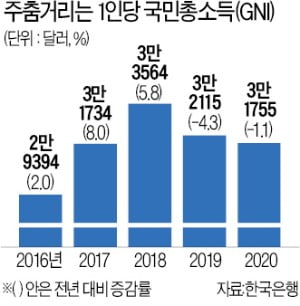
Due to the economic downturn caused by the novel coronavirus infection (Corona 19), the gross national income per capita (GNI) declined 1.1% last year and fell to the 31,000 dollar level. It is a decline for the second consecutive year following 2019 (-4.3%).
According to the ‘2020 National Income (provisional)’ announced by the Bank of Korea on the 4th, the GNI per capita last year was 31,755 dollars (37.47 million won). It was 1.1% less than in 2019 ($32,115).
GNI per capita is the total income earned by the people at home and abroad during the year, divided by the population, and is a representative indicator of the standard of living of the people. The deterioration of this indicator was largely due to a 1.0% drop in real economic growth last year. The decline in the growth rate has been 22 years since 1998 (-1.5%) during the financial crisis. There was also the effect of a 1.2% drop in the value of the won last year. When the value of the won falls, national income in terms of dollars decreases.
Korea’s national income rose to $33,564 in 2018 after opening the era of $30,000 in 2017 ($31,734). However, after falling 4.3% in 2019, it also declined last year, stepping backward for the second consecutive year. This is the first time since 2008-2009, during the global financial crisis, that the GNI per capita declined for the second consecutive year.
Korea’s per capita GNI is on the verge of being overtaken by Taiwan due to sluggishness for the last two years in a row. According to the Taiwan National Statistical Office, last year’s GNI per capita in Taiwan was $29,230, a 9.9% increase from the previous year. It is $2545 less than Korea. Considering that the difference between the two countries reached $7142 in 2018 alone, it has been chasing down the chin.
On the other hand, it is difficult to assure that Korea will overtake Italy. President Moon Jae-in said in his New Year’s address on January 11, “It is predicted that last year’s per capita national income will surpass the seven major countries (G7) for the first time in history.” Italy, one of the G7s, had a GNI per capita difference of only about $700 per person in 2019, but it was said that it would have reversed last year.
However, the GNI per capita last year, based on the euro recently announced by Italy, was 27,840 euros, and if the annual average dollar-euro exchange rate in the BOK economic statistics system is simply applied, it is calculated to be 31,790 dollars. Still more than Korea ($31,755). Shin Seung-cheol, head of the National Accounts Bureau of the Bank of Korea, said, “The GNI per capita in dollar terms can vary depending on which exchange rate indicator is used, so we have to wait for the official announcement of international organizations.”
On this day, the BOK announced that the growth rate in the fourth quarter of last year (compared to the previous quarter) was calculated at 1.2%. It rose slightly from the breaking news released in January this year (1.1%). Nevertheless, last year’s annual growth rate remained unchanged at -1.0%.
Reporter Seo Min-joon [email protected]
Ⓒ Hankyung.com prohibits unauthorized reproduction and redistribution
